Most of the other symbolic items that will be used in the coronation — known as “regalia” — will be presented to the king during the ceremony by peers from the House of Lords as well as senior bishops in the Anglican Church. Many of these items have great Christian significance and speak to the monarch’s role as a spiritual leader, according to a commentary sheet provided by the Church of England that explains all aspects of the liturgy.
“The regalia are deeply Christian, both in their imagery and the prayers that are used,” Vickers said.
Crown of St. Edward
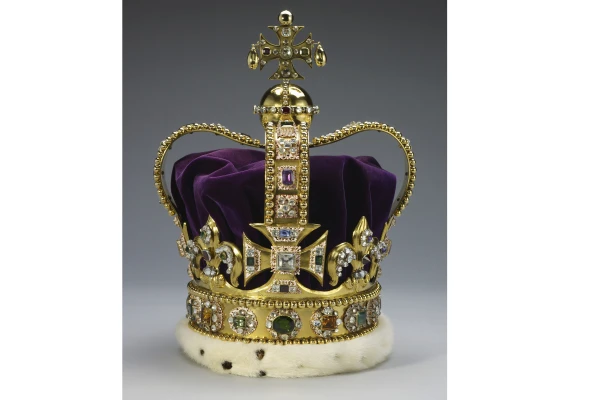 The Crown of St. Edward. Royal Collection Trust / © His Majesty King Charles III 2023
The Crown of St. Edward. Royal Collection Trust / © His Majesty King Charles III 2023
The coronation will be the first and only time that King Charles III will wear this crown; it was made for King Charles II in 1661 as a replacement for the medieval crown that was melted down in 1649. That original crown is thought to date back to the saintly King Edward the Confessor, the patron saint of kings in the Catholic Church. The crown is topped with an orb and a cross, symbolizing the Christian world. The king will exchange the Crown of St. Edward for the lighter Imperial State Crown, or Crown of State, at the end of the liturgy.
(Story continues below)
Sword of Spiritual Justice
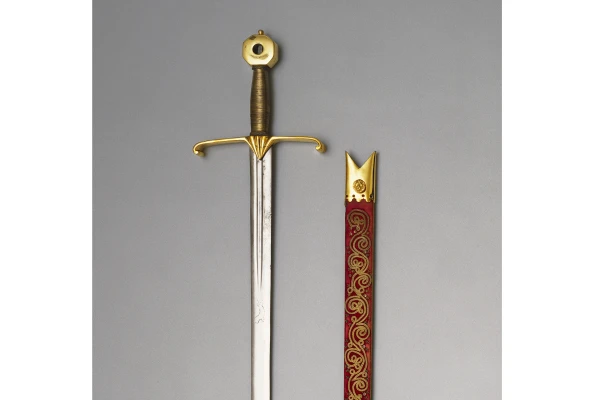 The Sword of Spiritual Justice. Royal Collection Trust / © His Majesty King Charles III 2023
The Sword of Spiritual Justice. Royal Collection Trust / © His Majesty King Charles III 2023
The king will be presented with several swords during the coronation, which are meant to evoke authority and justice. Perhaps most notable is the Sword of Spiritual Justice, signifying the monarch as defender of the faith.
Psalm 71, sung during the exchange of swords, will be sung by a Greek Orthodox choir in honor of King Charles III’s father, the late Prince Philip, who was baptized into the Greek Orthodox Church.
Orb
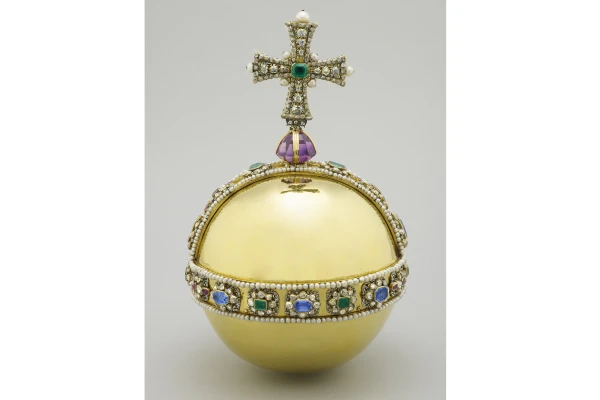 The Sovereign's Orb. Royal Collection Trust / © His Majesty King Charles III 2023
The Sovereign's Orb. Royal Collection Trust / © His Majesty King Charles III 2023
The orb is a golden ball, with a cross on the top, similar to the smaller one that is on the top of the Crown of St. Edward. The current orb was made in 1661. Vickers described this object as “perhaps the most Christian symbol of all” because it represents the world, the “temporal sphere, surmounted by the cross,” a reminder that Christ is the ruler of everything.
The three sections of the orb symbolize the three continents known to exist when it was created. The orb was most recently seen atop Queen Elizabeth’s casket, alongside other crown jewels.
Sovereign’s Ring
The Sovereign’s Ring is composed of a sapphire with a ruby cross set in diamonds. Vickers said the prayers during the conferral of the ring includes covenantal language that Catholics will recognize as being reminiscent of holy matrimony. The king pledges himself to the people who pledge themselves to him in a “deeply Christian understanding of a covenantal relationship,” he said.
Armills
The armills are gold bracelets thought to relate to ancient symbols of knighthood and military leadership. They serve in the coronation as “tokens of God’s protection,” Father Vickers noted.
Ampulla
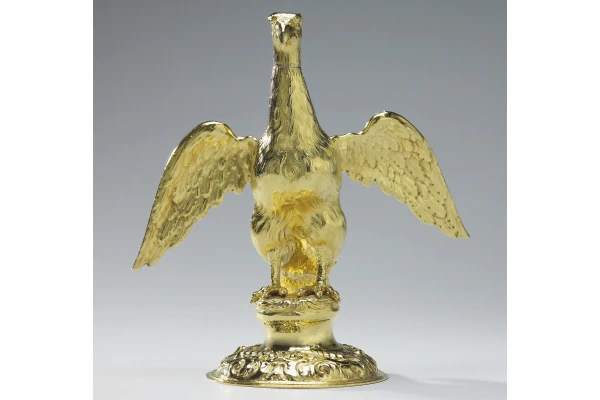
The Ampulla from which the chrism oil for King Charles III's anointing will be poured. Royal Collection Trust / © His Majesty King Charles III 2023
The ampulla is a small golden eagle that contains chrism oil for the king’s anointing (more on that in a moment.). According to the monarchy website, the current Ampulla was supplied for the coronation of King Charles II in 1661 and is based on an earlier, smaller vessel, which in turn was based on a 14th-century legend in which the Virgin Mary appeared to St. Thomas Becket and presented him with a golden eagle and a vial of oil for anointing future kings of England. The oil will be poured into a silver-gilt coronation spoon, which is the oldest object in use at coronations, having been first recorded in 1349.
Scepters
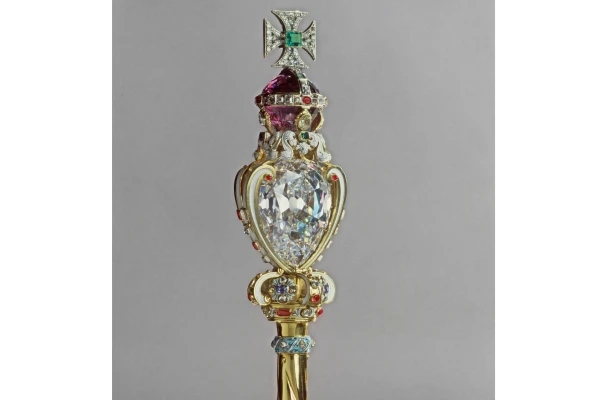 Sovereign’s Scepter with Cross. Royal Collection Trust / © His Majesty King Charles III 2023
Sovereign’s Scepter with Cross. Royal Collection Trust / © His Majesty King Charles III 2023
Two scepters, which symbolize the king’s temporal power, will be used during the coronation, and both contain explicitly Christian symbols. One of the scepters is topped with a cross and is associated with good governance. The other represents the king’s spiritual role and has an enameled dove on the top, a symbol of the Holy Spirit.
Anointing
As part of the coronation, the king’s head, hands, and breast will be anointed with chrism oil, which in the Catholic Church is most commonly associated with baptism and confirmation. This part of the ceremony will be done behind a screen, affording the new king his “only moment of privacy during the service, as he contemplates how he is called by God.”
The canopy screen symbolizes “the embrace, enveloping power, and presence of God during this moment,” the Church of England says. This part of the ceremony is described by the Anglican church as “the most solemn part of the coronation service, for by anointing the monarch is set apart or consecrated for the duties of a Sovereign.”
Examples of anointing abound in the Bible, especially as a means of consecrating, or setting aside for a holy purpose, priests and kings. The Gospel reading for the liturgy is from Luke 4:16-21, which speaks about Jesus’ anointing “to preach good news to the poor.”
The oil to be used for the coronation anointing was made from olives from the Mount of Olives and was consecrated in The Church of the Holy Sepulchre in Jerusalem, the traditional site of the death and resurrection of Jesus. It was co-consecrated by the Orthodox patriarch of Jerusalem, Theophilos III, and the Anglican archbishop in Jerusalem, Hosam Naoum.
The music that will be heard during the anointing is “Zadok the Priest.” Zadok was the priest who anointed King Solomon in the Old Testament book of 1 Kings. The words of the hymn have been sung at every coronation since King Edgar’s in 973, and since the coronation of George II in 1727 the setting by George Frideric Handel has always been used.
Vickers commented that the fact that anointing remained a part of the coronation ceremony — even throughout the Reformation — is remarkable, as many forms of anointing were rejected in the Church of England during that time. In Catholicism, anointing with oil is done as part of several of the sacraments, including baptism, confirmation, holy orders, and anointing of the sick.
Clothing
Many of the items of clothing that Charles will wear hold symbolic significance; here are a few examples.
Colobium Sindonis
A sleeveless linen tunic symbolizing purity and simplicity. The king will wear it after the anointing.
Supertunica
An embroidered gold coat that is a form of priestly robe, “which reminds all who see it that the king has been consecrated before God and in service of God.”
Oath
A key part of the coronation ceremony will be King Charles III’s oath to uphold the Protestant faith.
The king will pledge: “I Charles do solemnly and sincerely in the presence of God profess, testify, and declare that I am a faithful Protestant, and that I will, according to the true intent of the enactments which secure the Protestant succession to the Throne, uphold and maintain the said enactments to the best of my powers according to law.”
Vickers reiterated that it is important to take the coronation as an occasion to pray for the new monarch and that the overarching themes of the Christian service, which see the monarch putting himself in the mercy and protection of God, are praiseworthy.
“We need to be clear: It’s not a Catholic Mass, and he is taking an oath to maintain the Protestant, reformed religion. But I think we can, and in fact must, rejoice that it is in fact a Christian service,” he said.
Westminster Abbey
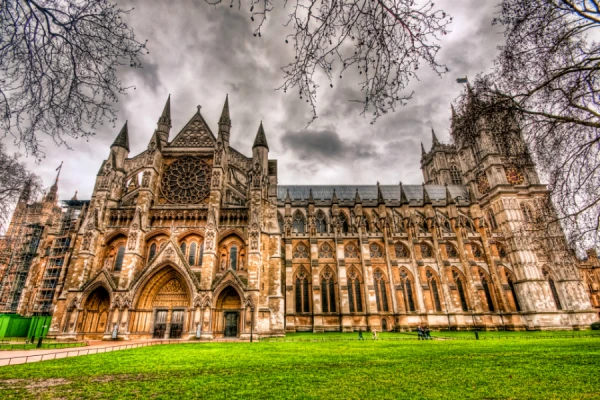
Westminster Abbey. hjjanisch via Flickr (CC BY-ND 2.0)
Westminster Abbey itself, the venue for every coronation for nearly 1,000 years, was built by St. Edward the Confessor, who died in 1066 and was buried there soon after the abbey’s dedication. Edward died childless, having made a vow of chastity. Though the abbey was taken over and is today a Protestant place of worship, its Catholic roots can still be seen in St. Edward the Confessor’s continued influence.
“When Henry VIII destroyed the abbeys and monasteries of England in the 16th century, he did not dare to touch St. Edward’s shrine at Westminster, so it is still there,” Bogle noted.
“People throng there to pray and light candles, and it is possible to have Mass there too on special occasions. St. Edward is regarded as a special patron for the monarchy of England.”
Jonah McKeown is a staff writer and assistant podcast producer for Catholic News Agency. He holds a Master’s Degree from the University of Missouri School of Journalism and in the past has worked as a writer, as a producer for public radio, and as a videographer.



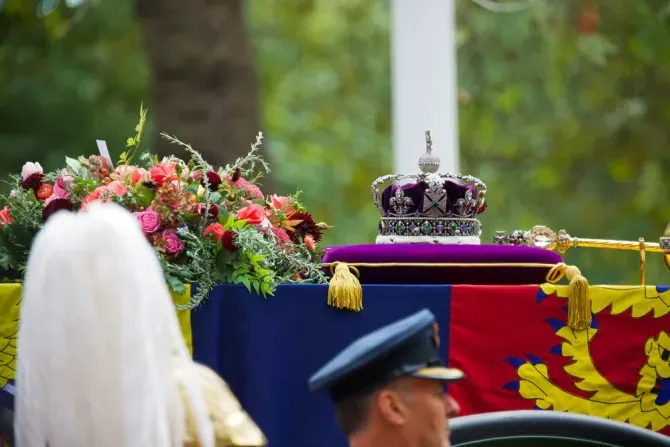
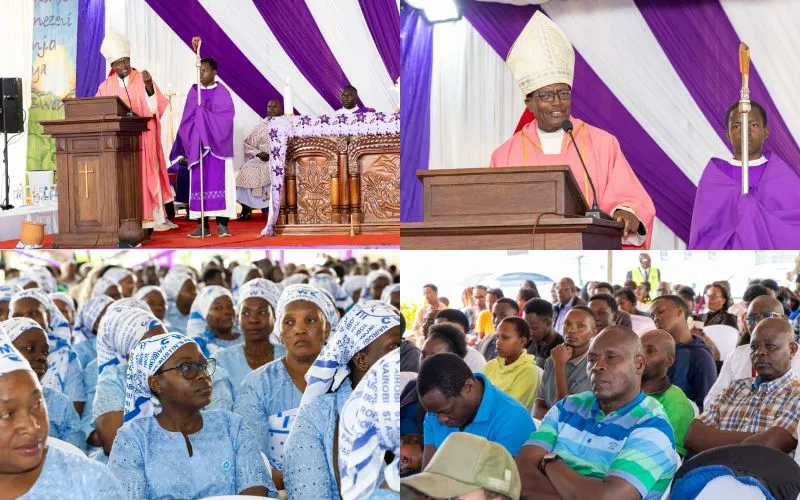
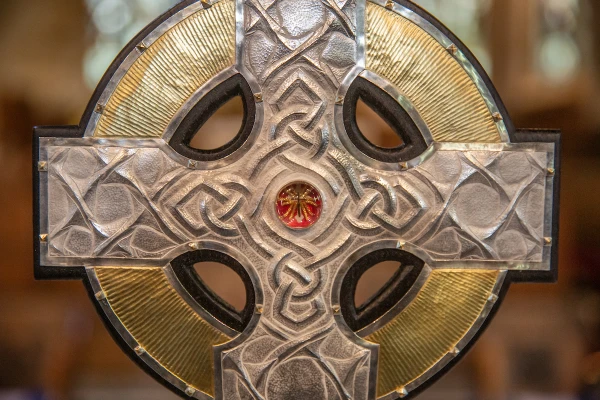 The precious relics from the true cross have been inlaid into the “Cross of Wales,” which will head Charles’ procession into Westminster Abbey, where he will be officially crowned. The Church in Wales
The precious relics from the true cross have been inlaid into the “Cross of Wales,” which will head Charles’ procession into Westminster Abbey, where he will be officially crowned. The Church in Wales The Crown of St. Edward. Royal Collection Trust / © His Majesty King Charles III 2023
The Crown of St. Edward. Royal Collection Trust / © His Majesty King Charles III 2023 The Sword of Spiritual Justice. Royal Collection Trust / © His Majesty King Charles III 2023
The Sword of Spiritual Justice. Royal Collection Trust / © His Majesty King Charles III 2023 The Sovereign's Orb. Royal Collection Trust / © His Majesty King Charles III 2023
The Sovereign's Orb. Royal Collection Trust / © His Majesty King Charles III 2023
 Sovereign’s Scepter with Cross. Royal Collection Trust / © His Majesty King Charles III 2023
Sovereign’s Scepter with Cross. Royal Collection Trust / © His Majesty King Charles III 2023



